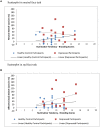Executive Control in Depressive Rumination: Backward Inhibition and Non-inhibitory Switching Performance in a Modified Mixed Antisaccade Task
- PMID: 28261121
- PMCID: PMC5306206
- DOI: 10.3389/fpsyg.2017.00136
Executive Control in Depressive Rumination: Backward Inhibition and Non-inhibitory Switching Performance in a Modified Mixed Antisaccade Task
Abstract
Background and objectives: The present study examines backward inhibition (BI) and non-inhibitory switching performance among depressed and healthy participants in a modified mixed antisaccade task. Specifically, sad and neutral faces were incorporated in the design to examine executive control difficulties associated with brooding trait.
Methods: Thirty-nine participants took part in the study, including 19 depressed patients and 20 healthy control subjects. Participants completed a diagnostic interview and self-report questionnaires, including the Beck Depression Inventory and Ruminative Response Scale-Brooding Subscale. They were then instructed to complete prosaccade and antisaccade trials in the pure and mixed blocks whereby eye gazes were tracked to assess inhibition and switching efficiency.
Results: For the switching effects, a significant group × brooding × task type interaction was found as hypothesized when multilevel modeling analysis was employed. Switching deficits associated with brooding was found to be greatest when sad faces were presented to depressed group. No significant results in BI or error rates were observed.
Conclusion: The patterns observed suggest that as opposed to BI, set shifting difficulty associated with brooding trait may be modulated by negative mood and cognition. In future research, emotional faces other than sad faces may be used to further explore if the observations could be generalized to other affective conditions.
Keywords: attention switching; depressive rumination; executive dysfunction; eye-tracking; mixed antisaccade task.
Figures




Similar articles
-
Attentional control deficits in social anxiety: Investigating inhibition and shifting functions using a mixed antisaccade paradigm.J Behav Ther Exp Psychiatry. 2018 Sep;60:46-52. doi: 10.1016/j.jbtep.2018.03.004. Epub 2018 Mar 19. J Behav Ther Exp Psychiatry. 2018. PMID: 29571005
-
Brooding rumination and attentional biases in currently non-depressed individuals: an eye-tracking study.Cogn Emot. 2017 Aug;31(5):1062-1069. doi: 10.1080/02699931.2016.1187116. Epub 2016 May 25. Cogn Emot. 2017. PMID: 27224305 Free PMC article.
-
Attention orienting and inhibitory control across the different mood states in bipolar disorder: an emotional antisaccade task.Biol Psychol. 2013 Dec;94(3):556-61. doi: 10.1016/j.biopsycho.2013.10.005. Epub 2013 Oct 22. Biol Psychol. 2013. PMID: 24161800
-
Switching and backward inhibition in major depressive disorder: the role of rumination.J Abnorm Psychol. 2012 Aug;121(3):570-8. doi: 10.1037/a0027474. Epub 2012 Apr 2. J Abnorm Psychol. 2012. PMID: 22468767 Free PMC article.
-
Attentional Disengagement Deficits Predict Brooding, but Not Reflection, Over a One-Year Period.Front Psychol. 2019 Oct 14;10:2282. doi: 10.3389/fpsyg.2019.02282. eCollection 2019. Front Psychol. 2019. PMID: 31681088 Free PMC article.
Cited by
-
Impact of ERP Reliability Cutoffs on Sample Characteristics and Effect Sizes: Performance-Monitoring ERPs in Psychosis and Healthy Controls.Psychophysiology. 2025 Feb;62(2):e14758. doi: 10.1111/psyp.14758. Psychophysiology. 2025. PMID: 39957549
References
-
- Bagby R. M., Rector N. A., Bacchiochi J. R., McBride C. (2004). The stability of the response styles questionnaire rumination scale in a sample of patients with major depression. Cogn. Ther. Res. 28 527–538. 10.1023/B:COTR.0000045562.17228.29 - DOI
-
- Beck A. T., Steer R. A., Brown G. K. (1996). Manual for the Beck Depression Inventory-II. San Antonio, TX: Psychological Corporation.
LinkOut - more resources
Full Text Sources
Other Literature Sources

